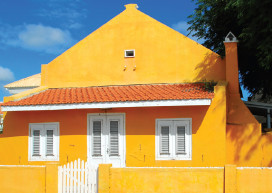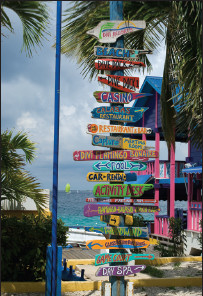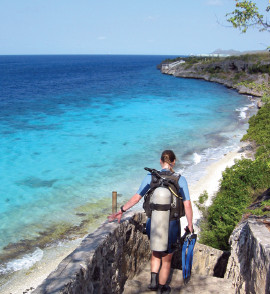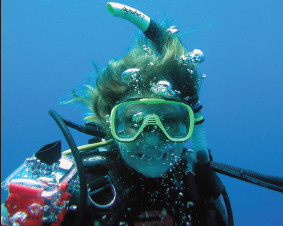BONAIRE
Dive into the Caribbean’s best-kept secret
The least-developed of the ABC Islands (which include gay-friendly Aruba and Curaçao), Bonaire lies 30 miles east of Curaçao and 50 miles north of the Venezuelan coast. Its dry, warm climate—and enviable yearly temperature of 82 degrees—is the result of constant trade winds that sweep away humidity. Beautiful Bonaire is one of the Caribbean’s bestkept secrets.
The island is a “special municipality” of the Netherlands, which means that Bonaire observes the same laws regarding LGBT equality as the Netherlands does. Same-sex marriage is legal, but same-sex weddings are generally not performed on the island. The local gay population blends seamlessly into the larger population, and there isn’t much stratification between gay and straight groups. You probably won’t find a gay disco on Bonaire, but you will encounter “family” at your hotel bar, local dive shop or street festival. Tune up your gaydar!
Most visitors to Bonaire aren’t going for the nightlife, anyway; they go for unforgettable diving, snorkeling and windsurfing. In the 1960s and 1970s, before many other countries were interested in natural resources conservation, Bonaire’s government enacted laws to protect fish, sea turtles and coral reefs. In 1979 all the waters and reefs surrounding the island were designated a National Marine Park, encompassing 2,700 hectares of reefs, seagrass beds and mangrove forests that provide habitats for a truly astounding variety of fish and shellfish. Today, Bonaire’s crystal-clear waters earn “World’s Best Dive Spot” crowns year after year, and the island’s tourism depends on its continuing stewardship of the reefs.
All life on Bonaire seems to revolve around its natural wonders. Most tourist accommodations, from bed-and-breakfasts to the bigger resorts, have an on-site dive shop, snorkel outfitter or scuba school. Dive spots are indicated by yellow-painted stones on the roadside; just park your bike or ask your taxi to drop you off, and within five minutes you’ll be face-to-face with tropical fish. Visitors can dive or snorkel from the beaches or from boats. The best sites are on the western edge of Bonaire and on the perimeter of Klein Bonaire, a small uninhabited islet off the west coast that is part of the National Marine Park.
Bonaire’s terrestrial attractions are typical of the arid Lesser Antilles. Crushed-coral beaches buffer the dry uplands from waves, while varieties of cacti and other succulent plants grow in the bright, tropical sun. At the northern end of Bonaire lies Washington Slagbaai National Park (washingtonparkbonaire.org), a sanctuary for wild parrots, parakeets, iguanas, waterfowl, sea turtles and Bonaire’s symbol, the flamingo. Up to 5,000 of the iconic pink birds flock within Bonaire’s extensive salt pans and saline ponds at a time.
Accommodations and Dining
No matter where you stay, you won’t be far from the sea. The capital city, Kralendijk, is located on the west coast of Bonaire and boasts the majority of tourist resorts and vacation rentals. Flamingo International Airport is just south of town, so almost any resort is but a short taxi ride away.
Dive fanatics swear by Captain Don’s Habitat (Kaya Gobernador Debrot 103, 599-717-8290, habitatbonaire.com), located 3 kilometers north of Kralendijk. The whitewashed cluster of villas, bungalows and oceanfront rooms overlook the water’s edge and Klein Bonaire. The proprietor, Captain Don Stewart, spearheaded the efforts to protect Bonaire’s natural heritage in the 1970s, and his resort is styled specifically for divers, snorkelers and nature lovers. That’s not to say the Habitat skimps on amenities. The on-site restaurant and pizza bar serves fresh catch of the day, pastas, surf-and-turf and tropical specialties; the freshwater pool overlooks the ocean; and the spa’s massage therapists can work out any kinks resulting from your daily dives. Even non-divers can appreciate the relaxed pace and unpretentious atmosphere at the Habitat—not to mention the stunning sunsets over the water.
Traditional resorts with hotel-style accommodations can also be found in the capital. One of the most elegant, Plaza Resort Bonaire (J.A. Abrahamboulevard 80, 599-717-2500, plazaresortbonaire. eu/en), places everything you’d need for a Caribbean vacation at your fingertips. Spread over six acres, the Plaza offers one of the island’s few large sandy beaches exclusively to resort guests, along with a full-service scuba and snorkeling outfitter. Want to explore Bonaire’s back roads? Rent a bicycle, scooter, car or boat from the resort or sign up for a custom adventure at the excursion desk. Take a dip in the pool if snorkeling feels like too much effort. Sip a fruity drink from the beach bar without leaving your chaise-lounge. The Plaza’s recently renovated suites, decorated in a stylishly urban mien, face the ocean or a garden terrace and contain two queens or one king bed, rainfall shower and dual sinks, air conditioning and Wi-Fi. Every service you’d need is within walking distance on the resort grounds.
Bonaire’s vacation villas offer a high degree of privacy and spacious accommodations for couples or larger groups. These rentals typically include full kitchens and baths, one or more bedrooms and access to a private swimming pool or garden. Ocean View Villas (Kaya Ir. Randolph Statius van Eps 6, 599-782-7100, oceanviewvillas.com), for example, is a collection of airy apartments and studios with high ceilings, rattan furniture and plenty of living space. The units are arranged around a sinuous swimming pool and palm garden. Rates are quite affordable, too.
Come nighttime, locals and tourists flock to Karel’s Beach Bar (Kaya J.N.E. Craane #12, 599- 717-8434, karelsbeachbar.com), Bonaire’s top nightclub. Perched on a concrete pier over the water, the different nightly parties feature DJs and drink specials. During the day, the bar serves breakfast, lunch, dinner and coffee, and patrons may soak up the rays on the outdoor patio.
Getting There
We won’t lie—flying to Bonaire is pricey compared to the Bahamas or Puerto Rico, but so worth it. Flights depart from New York and connect in Bogota, Colombia or Curaçao (or both), depending on the airline. Major U.S. airlines, including Continental and Delta, and many regional airlines all fly into Flamingo International Airport. So while it’s not the easiest place to access, Bonaire’s out-of-the-way location has helped to preserve its pristine beauty.








What Do You Think?